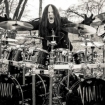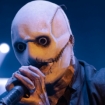This story was originally published in 2010.
Nestled in a modest vine-covered building along a drab stretch of Hollywood Boulevard far away from the gaudy L.A. tourist destinations of the Mann's Chinese Theatre and Hollywood Walk of Fame, the Museum of Death stands as a grim counterpoint to its hometown's obsession with beauty and youth. Containing a grisly cornucopia of serial-killer artwork, suicide-cult artifacts, and other stark images of death and depravity, the museum revels in the sick and twisted, catering to a crowd with strong stomachs and morbid sense of curiosity.
Which is why it's hardly shocking that Wednesday 13 and Joey Jordison are totally loving their private after-hours tour of the museum's collection. Longtime friends who collaborate in horror-rock side project the Murderdolls, they've never visited the museum before, but they instantly feel a kinship between their music's gruesome outrageousness and the frank depictions of our final destination all around them.
"I've always been fascinated with anything weird," Wednesday says, scoping out a display of exotic animal skulls. "I was the kid that always had fake hands and legs hanging from my ceiling, but I had Mötley Crüe posters on the wall as well. To me, horror and rock and roll just went hand in hand."
The band's first album, 2002's Beyond the Valley of the Murderdolls, combined Wednesday's twin passions, with a healthy dose of tongue-in-cheek humor thrown in for good measure. (Typical song title: "Graverobbing U.S.A.") But after eight years apart focusing on other projects — Jordison working with Slipknot and drumming with everyone from Rob Zombie and Korn to Norwegian black metallers Satyricon, and Wednesday focusing on Frankenstein Drag Queens from Planet 13, as well as his solo outfit — the band has reformed to release Women and Children Last (Roadrunner), a decidedly darker, more biting affair. "The songs [for Beyond the Valley] really represented a lot of teenage angst that we'd had. We lived in our parents' house, in the bedroom playing guitars," Wednesday explains. "Now flash-forward eight years later. A lot of shit has happened. We've had marriages that failed, houses that foreclosed, bankruptcy, drugs, drinking, flipping cars." He shakes his head. "Just … madness. I've created my own horror movie over the past eight years, and that's what this record is about."
Despite the recent real-life horror, in person, the two buddies display an almost playful comedic rapport: Both decked out in full makeup, Wednesday is the tall, lanky, extroverted jokester, while Jordison serves as his shorter, more deadpan counterpart.
Wednesday enters a room devoted to funeral homes, talking about the childhood influences that informed his twisted sensibility. "The Munsters is my favorite show," he says. "I used to sit in front of my TV every day and watch it. Addams Family, The Munsters — it was all about death. Then I saw Alice Cooper, how he incorporated humor. Dead babies, cutting heads off onstage — it's just comedy. That's what we do — that's what our thing is."
"I worked in a funeral home for five years," Jordison says. "My family owned five of 'em. That's how I learned to do makeup." He's unfazed by an instructional video playing in the corner that offers a step-by-step demonstration in preparing a corpse for viewing. "I've seen it all," he says.
Egging him on, Wednesday says to Jordison, "Tell 'im about when you had to store bodies behind your house."
"No, in my garage!" Jordison replies. "Our main funeral home was flooded, so we had to bring the bodies into my garage. It was fuckin' fucked up. They weren't embalmed yet, and with how hot it was, oh my god — they were bloated, and it stunk so fucking bad …"
Wednesday breaks into a big smile. "And people wonder why we make the music we do."
Of course, after years of not seeing each other, it seemed like the members of Murderdolls might never get back together to make another record. "There was a time when I was like, OK, he's gonna just do his solo stuff, and I'm down with that," Jordison says of their time apart. "But he's one of my best friends ever, and we lost touch for a little bit, and that sucked — I missed him. But I'm glad actually things happened the way they did, because if we'd made the next record [right after] it would have been just like the first one—just campier and funnier. But people are gonna be blown away by this record. It's heavy."
Wednesday nods in agreement. "It's scary, it's dark, and it's violent. The happiest song is called 'Summertime Suicide.'"
On the subject of offing oneself, discussion soon turns to the museum's Heaven's Gate exhibit room, complete with a recruitment video for the religious cult that committed mass suicide in March 1997. Wednesday and Jordison talk excitedly over one another as they peer into the room, which includes a sample of the cult's bunk beds and clothes.
"Those are the real outfits," Jordison enthuses.
"Holy shit!" Wednesday replies, barely able to contain himself. "I love this story!"
They take a moment to read a cult members' suicide note, but then Wednesday makes an announcement. "We gotta get into the Manson room," he says. "Manson's my favorite."
The room devoted to renowned psychopath Charles Manson is easy to spot: It's the one with the words "Helter Skelter" adorning the wall in blood red. And proving that he does indeed know his Manson history, Wednesday quickly points out that the Manson family misspelled the phrase as "Healter Skelter" when it appeared on a refrigerator in one of their victim's homes.
"I've been a Charles Manson … I wouldn't say 'follower,' but I've been interested in all his stuff," Wednesday says. "I've quoted him in songs. You know, as crazy as the guy is, I've sat and listened to him talk, and he makes complete sense to me. Or maybe I'm just out of my mind."
"Well, you are, though," Jordison responds with ace comic timing.
Wednesday looks at a photo of the madman staring back with steely defiance. "Would you buy a car from that guy?" he asks, laughing.
In an adjoining room, there is a wall of photographs of Manson's victims taken by the police after their slayings. It's a feast of bloody corpses, and the two musicians silently take it in. "Dude, I'd rather be shot than stabbed," Jordison finally declares. "You don't even feel it, really." He reflects for a moment and then adds, "This place is awesome."
They move on to a set of photos in honor of the 1947 Black Dahlia murder victim Elizabeth Short, who was killed about seven miles away from where we are now. It's a gripping juxtaposition of snapshots — there are glamour photos of Short from her acting years and then there are grisly images of her lacerated face and bifurcated corpse.
"She was hot," Jordison observes, sadness in his voice. "I still haven't seen the movie [the 1996 Brian De Palma-directed film The Black Dahlia]. I heard it was kinda lame."
Another infamous L.A. murder is depicted on the next wall: the 1994 killing of O.J. Simpson's wife, Nicole Brown, and Ron Goldman. Wednesday looks at artist's sketches from the trial and then turns to Simpson's mug shot: "I say, 'Guilty!'"
Murderdolls wield a wicked sense of gallows humor while they roam the hallways of the Museum of Death, clearly geeking out on an exhibit of punk-rocker G.G. Allin's insane prison writings and a display case of suicide cult-leader Jim Jones' photographs. But even these guys have their limits.
"I'm not really into watching operations," Wednesday admits. "That stuff makes me sick. I've got tattoos all down my arms and chest, but I don't like needles. And if I've been smoking weed, I can't watch Shark Week [on the Discovery Channel] — it creeps me out."
The two musicians look at a mounted series of graphic personal snapshots involving a romantic triangle gone bad: A wife and her boyfriend took pictures of their work as they methodically decapitated and defiled her husband. It's at this moment that Wednesday admits he got high before coming to the museum — right now he's regretting that decision. Still, he turns philosophical pondering the thin line that divides the demented from the truly murderous.
"These are the kind of people you pass in the supermarket every day," he says as he examines the snapshots. "And then you've got guys like us that just said, 'You know what? I think I'm just gonna play guitar.'"
"I'd rather plays drums and guitars," Jordison says, looking at the couple in the photographs carrying out their gruesome mission. "That just looks like too much work."
Wednesday is quick to declare that he would never commit any of the homicidal acts he sings about in Murderdolls' songs, but that doesn't keep him from imagining. "I always thought the perfect weapon is an icicle," he says. "You can fuckin' hack somebody up pretty bad with that, and then it melts." He smiles, an idea coming to him. "A guy who only kills during the winter and he uses icicles: Jack Frost!" He laughs at the new arch-villain he's created.
A gallery of car-accident photos from the 1930s and '40s catch their eye. The black-and-white images show the unspeakable carnage America's first cars caused to their passengers during collisions. In one photo, a dead motorist lies on the street, the bottom half of his face practically ripped off.
The Murderdolls bandmates seem a little unnerved by these automobile accidents, which makes sense since both band members have had near-death experiences behind the wheel. In September 2007, Wednesday flipped his car five times. And Jordison once rolled his car down a cliff after going too fast off an exit ramp. Both of them were drunk but walked away with only minor injuries and a few broken bones. "I'm fuckin' lucky, dude," Wednesday acknowledges.
With the tour winding down, the Murderdolls freak out over a John Wayne Gacy room, prompting Wednesday to wonder if he can sell any of his Gacy portraits to the museum. But the night's high spirits take a turn when they meet Museum of Death co-owner James "J.D." Healy and he offers heartfelt condolences about Paul Gray, Jordison's cohort in Slipknot who died in May of an accidental drug overdose. Jordison suddenly gets very quiet, speaking barely above a whisper. "Thanks, man," he says, trying not to lose his composure. "He was my best friend."
Clearly bummed, too, Wednesday tells Healy, "You just play on through it."
The Murderdolls may seemingly sport a cavalier attitude toward the Grim Reaper, both in their music and on their tour of the museum, but the truth is that they are all too intimately aware of the real, emotional consequences of death. Jordison, for one, is clearly still grappling with Gray's passing on a daily basis. And it's that struggle that has made his band with Wednesday so precious to him right now.
After Healy leaves, and as we prepare to leave the museum and head off into the warm L.A. night, Jordison says simply, "Slipknot doesn't even compute to me right now without [Gray]. He was my songwriting soul mate. If I didn't have [Murderdolls] …" His voice trails off. "…I don't know what I'd be doing."








